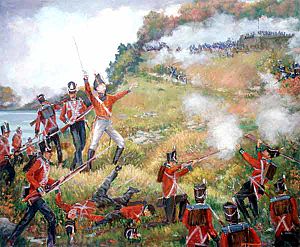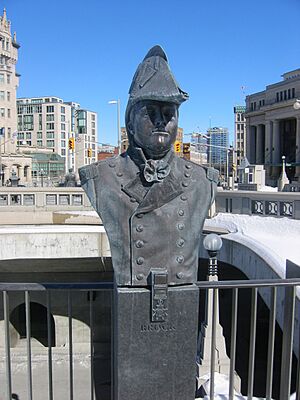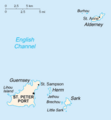Isaac Brock facts for kids
Quick facts for kids
Sir Isaac Brock
|
|
|---|---|

Portrait c. 1809, possibly by William Berczy
|
|
| Lieutenant Governor of Upper Canada | |
|
Acting
|
|
| In office 1811 – 13 October 1812 |
|
| Monarch | George III |
| Governor General | George Prévost |
| Acting for | Francis Gore |
| Succeeded by | Roger Hale Sheaffe |
| Personal details | |
| Born | 6 October 1769 St Peter Port, Guernsey |
| Died | 13 October 1812 (aged 43) Queenston, Upper Canada |
| Cause of death | Killed in action by a gunshot wound to the chest |
| Resting place | Brock's Monument, Queenston |
| Signature | |
| Nickname | "The Hero of Upper Canada" |
| Military service | |
| Allegiance | Great Britain (1785–1801) United Kingdom (1801–1812) |
| Branch/service | British Army |
| Years of service | 1785–1812 |
| Rank | Major-general |
| Commands | Upper Canada |
| Battles/wars | |
| Awards | Order of the Bath |
Major-General Sir Isaac Brock was a brave British Army officer and a leader from Guernsey. He was born on October 6, 1769, and died on October 13, 1812.
Brock was sent to Lower Canada in 1802. He commanded his soldiers in Upper Canada (which is now part of Ontario) for many years. He was promoted to major general and became responsible for defending Upper Canada from the United States.
Even though many people thought war could be avoided, Brock began to get his army and local citizen soldiers (called militia) ready. When the War of 1812 started, the people were prepared. Brock led quick victories at Fort Mackinac and Detroit. These wins stopped American invasion attempts.
Brock's actions, especially his success at Detroit, made him famous. He was even given a special honor called a knighthood in the Order of the Bath. People called him "The Hero of Upper Canada." His name is often remembered with the Native American leader Tecumseh. They worked together for a short time. Brock died during the Battle of Queenston Heights, which the British won.
Contents
Early Life and Education

Isaac Brock was born in St Peter Port on the Channel Island of Guernsey. He was the eighth son of John Brock, who was a midshipman in the Royal Navy.
From a young age, Brock was known as a hardworking student. He was also a great swimmer and boxer. At age ten, he went to school in Southampton, England. He also studied in Rotterdam, where he learned French.
Even though he didn't have a lot of formal schooling, Brock knew how important learning was. As an adult, he spent much time reading. He studied books on military tactics and science. He also read about ancient history and other interesting topics.
Brock was known for being a very tall and strong man. He was about 6 feet 2 inches (188 cm) tall. He was also considered handsome. However, he never married.
Military Career Begins
Brock had a very successful military career before the war. He rose through the ranks quickly. Many people noticed his fast promotions. Some thought it was luck, while others believed it was his skill.
Joining the Army
At fifteen, Brock joined the 8th (The King's) Regiment of Foot in 1785. He started as an ensign, which was a junior officer rank. His older brother, John, was already an officer in the same regiment.
Brock bought his promotions, which was common at the time. In 1790, he bought the rank of lieutenant. Later that year, he gathered his own company of men. This led to him becoming a captain in 1791. He then moved to the 49th Regiment of Foot.
Early Challenges and Battles
While serving in the Caribbean, Brock became very sick with a fever. He almost died. He didn't fully recover until he returned to England in 1793.
Back in Britain, he spent a lot of time recruiting new soldiers. In 1795, he bought the rank of major. He rejoined his regiment in 1796.
In 1797, Brock bought the rank of lieutenant-colonel. He became the leader of his regiment. In 1799, his regiment was sent to the Helder Expedition in the Netherlands.
Brock saw his first battle on September 10, 1799. On October 2, the 49th Regiment fought bravely in the Battle of Alkmaar. Brock was hit in the throat by a musket ball. Luckily, his neck cloth protected him from a serious injury. He quickly returned to duty.
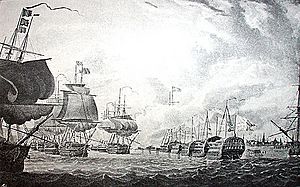
In 1801, Brock was present at the Battle of Copenhagen. His troops were ready to attack forts in the city. However, the sea battle ended before they were needed. Brock was able to see the brilliant tactics of Lord Nelson. After the battle, Brock celebrated the victory with Nelson. In 1802, Brock and the 49th Regiment were ordered to Canada.
Life in Canada
Brock arrived in Canada and was first stationed in Montreal. One of the biggest problems in Canada was soldiers running away (desertion). In 1804, seven soldiers stole a boat and escaped to the United States. Brock sent a group to catch them, even though they were on American soil. The men were captured.
Soon after, Brock heard about a plan for a mutiny at Fort George. Some soldiers planned to imprison their officers and escape to the U.S. Brock immediately went to Fort George. He quickly took control of the situation. He ordered the suspected leaders to be arrested.
The soldiers involved in the mutiny and desertion were sent to Quebec for a court martial. Some soldiers faced serious consequences for their actions. The mutineers said they were treated too harshly by another officer. They said they would not have acted this way under Brock's command.
Preparing for War
After a break in England, Brock returned to Canada in 1806. He was promoted to colonel. By this time, the United States was becoming very unfriendly towards the British Empire. Relations between the two nations got worse until the War of 1812 finally began.
The United States had several reasons for its anger. They were upset that the British navy was forcing American sailors to join their ships. They also disliked British restrictions on American trade. Some Americans wanted to gain more land by invading the British colonies in North America. They also believed the British were encouraging Native Americans to attack American settlements.
American leaders, called "War Hawks," wanted to invade Canada. They thought it would be easy. Some believed the United States should control all of North America.
Brock quickly worked to make Canada's defenses stronger. He improved the fortifications of Quebec. He also reorganized the Provincial Marine, which was in charge of transport on the lakes. He ordered new warships to be built. This naval force became very important during the war.
In 1807, Brock was made a brigadier general. In 1810, he took command of all forces in Upper Canada. In 1811, he was promoted to major general. He became the leader of both the military and civilian government in Upper Canada.
Brock had wanted to go to Europe to fight against Napoleon. But when he finally got permission in 1812, he decided to stay. He felt it was his duty to defend Canada.
As Upper Canada's leader, Brock made many changes to get ready for war. He changed the militia law to allow more volunteers. He also ordered better training for these new recruits. He kept strengthening defenses. Brock also met with First Nations leaders, like the Shawnee chief Tecumseh. He wanted to build alliances with them against the Americans.
The War of 1812 Begins
Capturing Detroit
The United States declared war on Britain on June 18, 1812. Brock was worried about Canada's safety. In Upper Canada, there were only a few British regular soldiers and some militia. These forces were spread out. Brock's advantage was that British ships controlled the lakes. This allowed him to move his soldiers quickly.
Brock kept his commanders informed. When war broke out, he sent a message to the British outpost at St. Joseph Island. The commander there, Captain Charles Roberts, was allowed to attack the nearby American outpost at Fort Mackinac. On July 17, the Americans were surprised and surrendered. This victory encouraged many First Nations tribes to join the British.
Brock wanted to do more. But he was limited by Governor General George Prevost. Prevost wanted to focus on defense and keep most of his forces in Lower Canada. Brock also felt that some officials in Canada were not eager to fight.
On July 12, an American army led by William Hull invaded Canada near Windsor. The invasion stopped quickly, and Hull retreated. This gave Brock a reason to ignore Prevost's orders. Brock gathered a small group of soldiers and volunteers. He set out on August 6 to reinforce the fort at Amherstburg.
At Amherstburg, Brock met Tecumseh. Brock was very impressed by him. Brock also read American messages captured from Hull's army. He realized Hull was timid and afraid of the First Nations. He also saw that the American soldiers were losing hope and low on supplies. Against the advice of his officers, Brock decided to attack Detroit.
Even with his First Nations allies, Brock was outnumbered. He had about 600 First Nations warriors and 1,300 soldiers. Hull had 2,500 soldiers.
Brock decided to use tricks to scare Hull. He dressed his militia in uniforms that looked like British regular soldiers. This made it seem like he had a much larger force. Brock laid siege to Fort Detroit. He had his cannons fire at the fort from across the river. He also had Tecumseh's warriors march in front of the fort many times. This made it look like there were many more warriors than there actually were.
Brock sent Hull a letter demanding his surrender. He wrote that he did not want a "war of extermination." But he warned that the many First Nations warriors with his troops would be "beyond my control" once fighting began.
On August 16, Hull surrendered. Hull was an older general with little recent military experience. He was terrified of losing the battle. He later wrote that surrendering saved his 2,500 troops and 700 civilians from "the horrors of an Indian massacre."
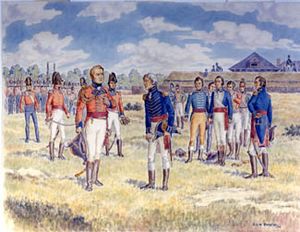
The capture of Detroit greatly hurt American morale. It also removed the main American army in the area. At the same time, it boosted the morale of Brock's forces. Brock used the captured American supplies for his own soldiers. The victory also secured the support of Tecumseh and his allies. They saw Brock's actions as a sign of his skill and willingness to fight.
Tecumseh respected Brock greatly. He reportedly said, "This is a man" after meeting him. Brock also thought highly of Tecumseh. He called him "the Wellington of the Indians." Brock promised Tecumseh that he would not make a peace treaty without addressing the Shawnee's dream of an independent homeland.
The capture of Detroit gave the British control over most of Michigan Territory. Brock wanted to continue his campaign into the U.S. But Prevost negotiated a ceasefire with the Americans. This stopped Brock's momentum. It also gave the Americans time to regroup and prepare to invade Canada. Brock worked hard to prepare defenses across Upper Canada.
Death at Queenston Heights
Meanwhile, American general Stephen Van Rensselaer III was pressured to invade Canada. He commanded a large army near Lewiston. On October 13, 1812, he tried to cross the Niagara River. This led to the Battle of Queenston Heights.
Despite heavy fire from British cannons, the first American soldiers landed. They then climbed a path up to the heights. From there, they attacked and captured the British cannons. Brock had just arrived from nearby Fort George. He had moved to the cannon battery to get a better view. He and his men were forced to quickly retreat.
Brock feared that more Americans would cross the river. He ordered an immediate attack on their position. He always led his men from the front. Brock personally led the charge on foot. His attack was made by soldiers from the 49th Regiment and some militia.
The attack was stopped by heavy fire. Brock was hit in the wrist by a musket ball. But he kept pushing forward. His height, officer's uniform, and a bright sash made him an easy target. An American soldier fired at him from about fifty yards away. The musket ball hit Brock in the chest, and he fell.
It is believed Brock died almost instantly without speaking. His body was carried from the field to a nearby house.
After Brock's death, Lieutenant-Colonel John Macdonell took command. He led a second attempt to retake the position. His small force of about 70 to 80 men fought bravely. They even used "Revenge the General" as a battle cry.
Macdonell's horse was hit, and then he was shot in the back. He fell from his horse and later died from his injuries. Other officers were also wounded. The British forces had to retreat.
Later that afternoon, General Sheaffe arrived with more soldiers. He took command. Sheaffe used a more careful approach. This led to a complete victory over the Americans.
Brock's Burial

After the battle, Brock and Colonel Macdonell were buried. On October 16, a funeral procession went from Government House to Fort George. Soldiers and First Nations warriors lined the route. The coffins were placed in a grave at Fort George. The British fired a twenty-one gun salute. The American soldiers at Fort Niagara also fired a salute out of respect. Over five thousand people attended the funeral.
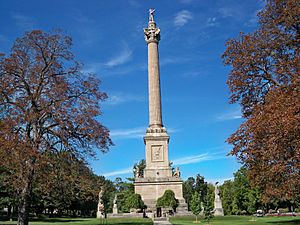
A small pile of stones marks the spot where Brock fell. In 1824, Brock's and Macdonell's remains were moved to Brock's Monument. This monument overlooks the Queenston Heights. The original monument was damaged in 1840. A larger, 185-foot (56 m) tall monument was built to replace it. Brock's remains were reburied inside the new monument on October 13, 1853. An inscription on the monument honors him as a hero who defended Upper Canada.
Brock's Legacy
Impact on British Leadership
Brock's death was a big loss for British military leadership. His successor, Major-General Sheaffe, was successful at Queenston Heights. But he was criticized for his retreat at the Battle of York. He was later sent back to England.
Brock's successor at Detroit, Colonel Henry Procter, did not do as well. He faced an attack from an American army led by William Henry Harrison. Procter's forces were defeated at the Battle of the Thames in 1813. Procter's soldiers fled, leaving Tecumseh and his First Nations warriors to fight alone. Tecumseh died in this battle, and the alliance with the First Nations ended.
Governor General Prevost, who often disagreed with Brock, remained in command. He was later criticized for his actions at the Battle of Plattsburgh in 1814. He was recalled to England to face an inquiry.
Remembered in Britain
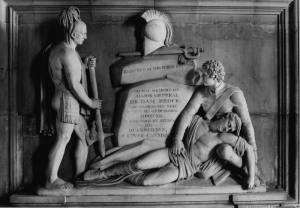
Even though Brock's achievements were smaller than the huge battles in Europe, his death was noticed. Especially in his home, Guernsey. In London, there is a memorial for him in St Paul's Cathedral. The British government also gave money to his four surviving brothers.
For his actions at Detroit, Brock was made a Knight Companion of the Order of the Bath. He died before he learned of this honor.
A British naval ship was named HMS Sir Isaac Brock in his honor. It was destroyed during construction to prevent it from being captured by the enemy.
Honored in Canada
Canadians see Brock as one of their greatest military heroes. He was voted number 28 on the television show The Greatest Canadian.
Brock didn't always feel at home in Canada. He saw it as a quiet place and wanted to return to Europe to fight Napoleon. He also didn't fully trust all Canadian colonists. He worried some might support the Americans. He preferred to use British regular soldiers and Tecumseh's warriors.
Over time, some stories and myths about Brock have appeared. For example, a story about him being engaged to Sophia Shaw was published in 1908. But there is no proof for this. A legend about his horse, Alfred, was published in 1859. The horse was supposedly shot during the battle. But records show his horse was present at his funeral.
Many places in Canada are named after Brock. These include Brockville and Brock in Ontario, and Brock in Saskatchewan. General Isaac Brock Parkway and Brock University in St. Catharines, Ontario, are also named for him. Many schools in Canada bear his name.
In 2012, the Royal Canadian Mint released a special gold coin to honor 200 years since Brock's death. The design was based on an old coin made in 1816 to remember Brock.
Guernsey's Tribute
Brock's childhood home in St Peter Port, Guernsey, is still standing. It has a special plaque. There is also a memorial for him in the Town Church, paid for by Canada.
Brock University in Ontario offers scholarships to students from Guernsey who get good grades. In 1969, the Guernsey Post Office issued postage stamps to celebrate his life and achievements.
Images for kids




